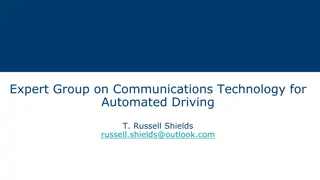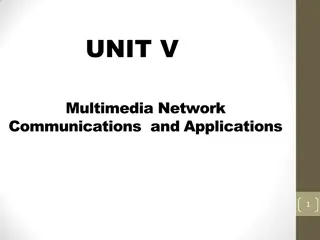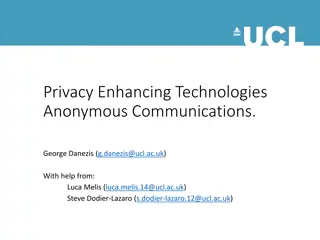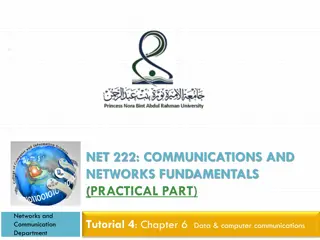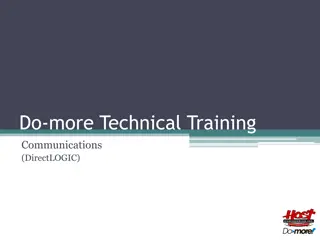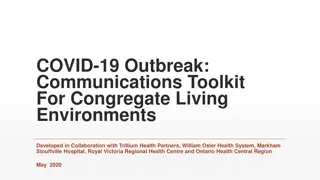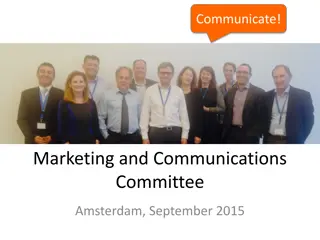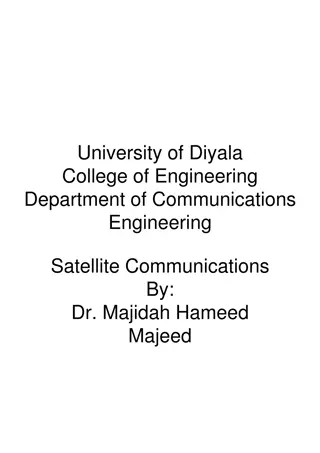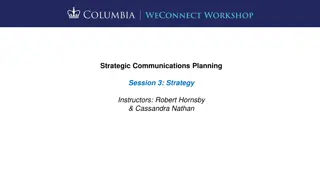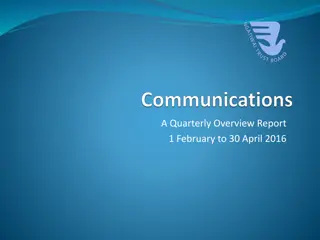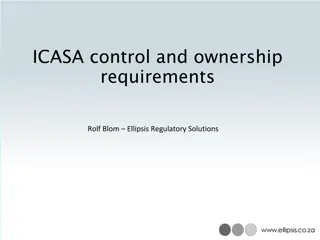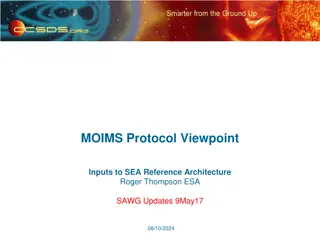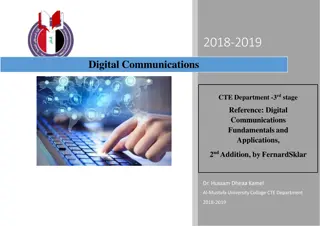Apache MINA: High-performance Network Applications Framework
Apache MINA is a robust framework for building high-performance network applications. With features like non-blocking I/O, event-driven architecture, and enhanced scalability, MINA provides a reliable platform for developing multipurpose infrastructure and networked applications. Its strengths lie i
3 views • 13 slides
Satellite Communications Support for Enhanced Emergency Communications
Providing support for enhanced emergency communications through mobile and fly-away satellite systems. These systems offer cellular-based WiFi, satellite-based WiFi, and voice over IP phone numbers for use during communication disruptions. Satellite airtime is provided at no cost to TxDOT through th
2 views • 4 slides
Modeling and Generation of Realistic Network Activity Using Non-Negative Matrix Factorization
The GHOST project focuses on the challenges of modeling, analyzing, and generating patterns of network activity. By utilizing Non-Negative Matrix Factorization (NMF), realistic network activity patterns can be created and injected into live wireless networks. Understanding and predicting user behavi
4 views • 28 slides
Automated Anomaly Detection Tool for Network Performance Optimization
Anomaly Detection Tool (ADT) aims to automate the detection of network degradation in a mobile communications network, reducing the time and effort required significantly. By utilizing statistical and machine learning models, ADT can generate anomaly reports efficiently across a large circle network
8 views • 7 slides
Texas FFA Agricultural Communications Career Development Event 2023
The 2023 Texas FFA Agricultural Communications Career Development Event offers a comprehensive schedule including team orientation, press conference, quizzes, practicums, and more. Contestants will engage in activities such as a communications quiz, editing exercise, practicum work, and web design.
1 views • 20 slides
CEPT Workshop on 6G Mobile Communications: Numbering & Network Issues
CEPT Workshop on 6G Mobile Communications, led by Elizabeth Greenberg of Ofcom UK, addresses the role of numbering and networks in the ECC, numbering considerations for 6G, and how WG NaN contributes to the development of numbering for 6G technologies. Key topics include ensuring non-discriminatory
1 views • 8 slides
Expert Group on Communications Technology for Automated Driving
The Expert Group on Communications Technology for Automated Driving, established by ITU, focuses on key topics such as V2V communications capabilities, protecting vulnerable road users, and matching service life of communications equipment with automobiles. The group recently had its first meeting t
0 views • 7 slides
Revolutionizing Network Management with Intent-Based Networking
Explore the concept and benefits of Intent-Based Networking (IBN) in simplifying network configuration and enhancing efficiency. Learn how IBN automates network operations, aligns with business objectives, improves security, and ensures scalability and reliability. Discover the potential of IBN tool
0 views • 14 slides
Network Compression Techniques: Overview and Practical Issues
Various network compression techniques such as network pruning, knowledge distillation, and parameter quantization are discussed in this content. The importance of pruning redundant weights and neurons in over-parameterized networks is highlighted. Practical issues like weight pruning and neuron pru
0 views • 37 slides
Fundamentals of Data Communications: Characteristics and Components
Data communications involve the exchange of data between devices through transmission mediums. The effectiveness of a data communications system relies on key characteristics like delivery, accuracy, timeliness, and jitter. The system components include the message, sender, receiver, transmission me
0 views • 63 slides
Network Slicing with OAI 5G CN Workshop Overview
Overview of Network Slicing with OAI 5G CN workshop focusing on the crucial role of network slicing in realizing the service-oriented 5G vision. This workshop covers topics like multiple logical networks creation on shared infrastructure, different types of network slices, preparation and instantiat
1 views • 6 slides
Network Design Challenges and Solutions in Business Data Communications
Issues in designing a Local Area Network (LAN) include needs analysis, technological design, and cost assessment. The traditional approach involves structured systems analysis, but faces challenges due to rapidly changing technology and increasing network traffic. The Building Blocks Approach recomm
1 views • 20 slides
Understanding Multimedia Network Communications and Applications
Multimedia network communications involve high data rates, real-time interaction, and varied quality of service parameters like data rate, latency, packet loss, jitter, and synchronization. Different multimedia service classes cater to specific requirements such as real-time, priority data, silver,
0 views • 22 slides
Understanding Snort: An Open-Source Network Intrusion Detection System
Snort is an open-source Network Intrusion Detection System (NIDS) developed by Cisco, capable of analyzing network packets to identify suspicious activities. It can function as a packet sniffer, packet logger, or a full-fledged intrusion prevention system. By monitoring and matching network activity
0 views • 23 slides
Enhancing Privacy and Anonymous Communications with Technology
Explore the world of Privacy Enhancing Technologies (PETs) and Anonymous Communications through the work of George Danezis and his team at UCL. Dive into the challenges of network identity, lack of privacy, and weak identifiers in today's digital landscape. Learn about Ethernet and IP packet formats
0 views • 49 slides
Transportation Network Modeling and Analysis with C.Coupled SE Platform
This content outlines the features and functionalities of the C.Coupled SE Platform (CSET Platform) developed by the Connetics Transportation Group. It covers aspects such as interface design, inputs merging, purposes, platform development using Cube, TAZs merging, and network attributes. The platfo
0 views • 11 slides
Fundamentals of Data and Computer Communications Explained
In this tutorial, we delve into Chapter 6 of data and computer communications, focusing on transmission overhead calculations, asynchronous and synchronous communication comparisons, CRC computation, and character transmission requirements. Learn about start bits, stop bits, control bits, parity bit
1 views • 12 slides
DirectLOGIC Communications Training Overview
Explore the technical training communications for Do-more DirectLOGIC systems, focusing on setting up communication between DL Servers and Clients using built-in Ethernet ports and ECOM100 modules. Learn about communication configurations, memory allocation, and parameter settings to establish effec
0 views • 28 slides
Instant Communications in Emergency Situations: Clear Channel Network Protocol
The Gulf Coast of Texas faces frequent tropical storms and hurricanes, requiring clear communication strategies. Clear Channel's network of digital units provides vital messaging during emergencies, ensuring public safety. The network protocol involves coordinating messages with emergency management
0 views • 22 slides
COVID-19 Outbreak Communications Toolkit for Congregate Living Environments
This communications toolkit, developed in collaboration with multiple health organizations, provides guidance and resources for managing communication during a COVID-19 outbreak in congregate living environments. It includes information on processes, notifications, web updates, media relations, key
0 views • 34 slides
Meridian: An SDN Platform for Cloud Network Services
Meridian is an SDN platform developed by Mohammad Banikazemi, David Olshefski, Anees Shaikh, John Tracey, and GuohuiWang at IBM T. J. Watson Research Center. The platform focuses on providing cloud network services efficiently. It encompasses an architecture that enables faster and more convenient n
0 views • 21 slides
Unlocking Total Value with Hosted Communications for Your Business
Business communications are evolving, with hosted solutions offering more than just cost savings. They provide flexibility, productivity enhancements, and future-proofing benefits for businesses of all sizes. Switching to a hosted communications solution like [Product Name] can lead to immediate cos
0 views • 4 slides
Understanding the Fiduciary Duty Exception to Attorney-Client Privilege
Several courts have deliberated on extending attorney-client privilege to protect communications between law firms' in-house counsel seeking advice on handling potential malpractice claims. This exception, known as the fiduciary duty exception, has faced scrutiny and rejection in recent cases, safeg
0 views • 36 slides
Enhancing Alliance Strategy Implementation through Effective Communications
This internal communications session aims to establish a framework for Secretariat communications to assist Members in strengthening the Alliance. Key focuses include aligning with the 2016-2021 Alliance strategy, identifying potential gaps, and devising strategies to address them for improved colla
0 views • 6 slides
Communicate! Marketing and Communications Committee Amsterdam Meeting Summary September 2015
The meeting of the Communicate! Marketing and Communications Committee in Amsterdam focused on various themes such as clean air, public communications, public acceptance, gas innovation, and marketing campaigns. Members discussed cooperation with the IGU Presidency to support clean air campaigns, ra
0 views • 12 slides
Understanding Sexual Assault Communications Privilege and Balancing Public Interests
Exploring the complexities and practical challenges surrounding Sexual Assault Communications Privilege (SACP), this content delves into the reasons for its establishment, the services it provides, and the implications for both defence lawyers and complainants in sexual assault trials. It sheds ligh
0 views • 19 slides
Partnership Internal Communications Plan & Stakeholder Analysis
Developing an effective internal communications plan for a partnership involves drawing insights from stakeholder analysis, drafting, validating, and implementing the plan. Engaging with internal stakeholders, understanding their awareness, engagement levels, and expectations, and prioritizing commu
1 views • 6 slides
Understanding Satellite Communications and Orbits in Engineering
Exploring the intricacies of satellite communications and orbits in engineering, focusing on special types of inclined orbits, circular orbits, elliptic orbits, and the calculation of eccentricity. Examples such as the International Space Station's orbit are used to illustrate concepts. The content
0 views • 17 slides
Understanding Network Analysis: Whole Networks vs. Ego Networks
Explore the differences between Whole Networks and Ego Networks in social network analysis. Whole Networks provide comprehensive information about all nodes and links, enabling the computation of network-level statistics. On the other hand, Ego Networks focus on a sample of nodes, limiting the abili
0 views • 31 slides
Understanding Strategic Communications Planning
This content delves into the intricacies of strategic communications planning, covering topics such as defining communication goals, elements of a communications plan, and the importance of strategy in various arenas. The importance of strategy in connecting purpose, audience, and outcomes is emphas
0 views • 22 slides
Quarterly Overview Report: Feb-April 2016 for NTB Communications
Highlights include successful workshops on communication strategy, website revamp, and monthly communications activities. NTB also provided regular updates through newsletters and board meeting summaries. Various other panui were shared via mail, website, and social media. Barry Caldwell is the main
0 views • 4 slides
Understanding ICASA Control and Ownership Requirements
In South Africa, the Independent Communications Authority of South Africa (ICASA) regulates the licensing framework for electronic communications services. ICASA's mandate involves establishing licensing frameworks, promoting ownership by historically disadvantaged groups, and supporting black econo
0 views • 14 slides
MOIMS Protocol Viewpoint for SEA Reference Architecture Updates
This content describes the MOIMS Protocol Viewpoint inputs to the SEA Reference Architecture updates by Roger Thompson from ESA SAWG. It includes details about the graphical conventions, data store elements, organizational domains, network layers, communications protocols, and space communications c
0 views • 21 slides
Underwater Light Communications in November 2017
Discusses the advantages of light communications (LC) for underwater use, such as high data rate, low latency, and cost-effectiveness. Contrasts LC with acoustic and RF methods, highlighting benefits and limitations. Explores use cases including communication between submarines, divers, oil platform
0 views • 5 slides
Network Function Virtualization (NFV) Overview
Network Function Virtualization (NFV) focuses on virtualizing network functions to improve efficiency and reduce costs in network infrastructure. The lecture discusses key readings, devices that compose a network, specialization of devices, benefits of one-device-does-anything approach, and the goal
0 views • 21 slides
Enhancing Network Stability with Network Monitoring Systems
Network monitoring is crucial for efficient management and proactive issue detection in a network environment. Factors influencing an effective network system include choosing the best OEM, SLA agreements, and selecting a reliable System Integrator. Reactive monitoring can lead to financial losses a
0 views • 12 slides
Understanding Digital Communications in CTE Department: Concepts and Applications
In the realm of Digital Communications at the CTE Department, delve into a thorough exploration of fundamental principles and practical applications. Concepts such as television signal transmission, binary PCM, quantization levels, code word lengths, transmission bandwidth, signaling rates, and nois
0 views • 8 slides
Integration of Light Communications for Enhanced Reliability in Multilink Operations
The presentation discusses the integration of Light Communications (LC) into the Multilink Operation (MLO) framework to enhance reliability and reduce latency in wireless communications. By proposing the incorporation of LC as a new offloading opportunity within the MLO framework, the potential for
0 views • 15 slides
Accelerating Systemic Change Network Inaugural Workshop Summary
The Accelerating Systemic Change Network held its inaugural workshop at Howard Hughes Medical Institute in July 2016 to address the lack of coordination in improving higher education. With a vision to become a professional hub for change researchers in STEM education, the network aims to enhance ind
0 views • 5 slides
University Network Section Overview July 2015 - March 2016
The presentation covers the network team structure, team members, objectives, goals, report outline, network statistics, accomplishments, and future plans of the university network section from July 2015 to March 2016. It highlights efforts to provide stable internet and intranet services, restructu
0 views • 16 slides






